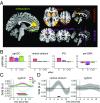Distinct encoding of decision confidence in human medial prefrontal cortex
- PMID: 29784814
- PMCID: PMC6003322
- DOI: 10.1073/pnas.1800795115
Distinct encoding of decision confidence in human medial prefrontal cortex
Abstract
Our confidence in a choice and the evidence pertaining to a choice appear to be inseparable. However, an emerging computational consensus holds that the brain should maintain separate estimates of these quantities for adaptive behavioral control. We have devised a psychophysical task to decouple confidence in a perceptual decision from both the reliability of sensory evidence and the relation of such evidence with respect to a choice boundary. Using human fMRI, we found that an area in the medial prefrontal cortex, the perigenual anterior cingulate cortex (pgACC), tracked expected performance, an aggregate signature of decision confidence, whereas neural areas previously proposed to encode decision confidence instead tracked sensory reliability (posterior parietal cortex and ventral striatum) or boundary distance (presupplementary motor area). Supporting that information encoded by pgACC is central to a subjective sense of decision confidence, we show that pgACC activity does not simply covary with expected performance, but is also linked to within-subject and between-subject variation in explicit confidence estimates. Our study is consistent with the proposal that the brain maintains choice-dependent and choice-independent estimates of certainty, and sheds light on why dysfunctional confidence often emerges following prefrontal lesions and/or degeneration.
Keywords: confidence; decision making; fMRI; medial prefrontal cortex.
Conflict of interest statement
The authors declare no conflict of interest.
Figures




References
-
- Meyniel F, Sigman M, Mainen ZF. Confidence as Bayesian probability: From neural origins to behavior. Neuron. 2015;88:78–92. - PubMed
-
- Kepecs A, Uchida N, Zariwala HA, Mainen ZF. Neural correlates, computation and behavioural impact of decision confidence. Nature. 2008;455:227–231. - PubMed
-
- Bang D, et al. Confidence matching in group decision-making. Nat Hum Behav. 2017;1:0117.
Publication types
MeSH terms
Grants and funding
LinkOut - more resources
Full Text Sources
Other Literature Sources

